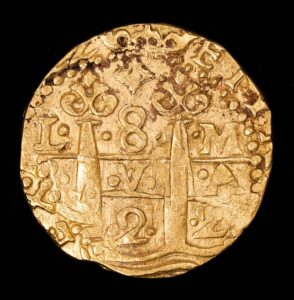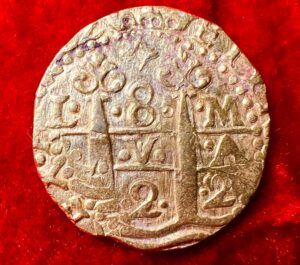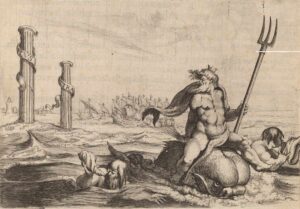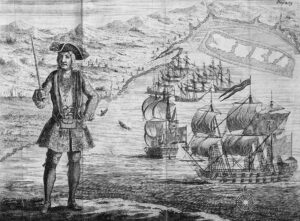From 1696 to 1750 the Spanish Colonies in Mexico, Columbia, and Peru were producing tons of gold coins for the Spanish empire. The mint in Lima, Peru alone produced hundreds of thousands of “escudos de oro” or “shields of gold”. These were made in 1,2-,4-, and 8-escudo denominations.
 The largest of these coins was the 8 escudos which typically weighed just over 27 grams of 22k gold. Most of the gold used for the Lima coinage came from Inca gold captured by soldier/explorers known as conquistadores. This gold was melted into thin bars, cut into round planchets, heated, and then struck with a hammer and die to imprint the design.
The largest of these coins was the 8 escudos which typically weighed just over 27 grams of 22k gold. Most of the gold used for the Lima coinage came from Inca gold captured by soldier/explorers known as conquistadores. This gold was melted into thin bars, cut into round planchets, heated, and then struck with a hammer and die to imprint the design.
Coins minted in the New World were carefully counted and documented in manifests by the mint assayer before being shipped back to Spain in convoys or “flotillas”. Once in Spain, the New World gold was re-melted and converted into traditional Spanish coinage.
However, many of the gold shipments were intercepted by opposing navies, privateers, or pirates and some went down with their ships in storms and hurricanes. To this day, precious few Lima 8 escudos have survived and those that have are highly prized by collectors.
The Design Elements of the 1722 Obverse
 Although not visible on this specimen due to the die being larger than the planchet, the legend on the pillars side or “obverse” of this rare 1722 Lima 8 escudos should read “ET YNDIARVM REX ANO 1722”. The translation in English is: “And of the Indies King year 1722”. During the time this coin was minted, the New World was commonly known to the Spanish as “The Indies.”
Although not visible on this specimen due to the die being larger than the planchet, the legend on the pillars side or “obverse” of this rare 1722 Lima 8 escudos should read “ET YNDIARVM REX ANO 1722”. The translation in English is: “And of the Indies King year 1722”. During the time this coin was minted, the New World was commonly known to the Spanish as “The Indies.”
The letters and number in the center portion of the pillar side of the coin (L.8.M over P.V.A.) represent the following: “L” is for the Lima mint, 8 is for the denomination of 8 escudos, “M” is for the mint assayer “Christobal Cano Melgarejo” and “PVA” is a Latin abbreviation for “PLVS ULTRA”, which being translated into English means “Further Beyond” implying that the pillars were a gateway. Prior to the discovery of the New World in 1492 by Christopher Columbus, it was believed that beyond the pillars of Hercules was the end of the world. With the discovery of the Americas, the myth was laid to rest that the Pillars of Hercules was the westernmost edge of the inhabitable world which had prevailed since Antiquity. (To this day, “Plus Ultra” is the royal motto of Spain.) 
The vertical pillars of Hercules rising from the waves with their chapiters represent the Straits of Gibraltar with one pillar marking the Rock of Gibraltar and the other across the strait marking one of the mountain peaks in Morocco as either Jebel Moussa (Musa), in Morocco, or Mount Hacho (held by Spain), near the city of Ceuta (the Spanish exclave on the Moroccan coast).
Above the number 8 is a star, which was a design change that started in 1716. Some believe this star symbolizes the North star, which sailors used for navigating the seas and above this is a crown representing the kingdom of Spain.
The Design Elements of the Reverse
 The legend on the cross-side should read “PHILIPPVS V D. G. ISPANIAR”, which is an abbreviation in Latin for “PHILIPPVS V DEI GRATIA HISPANIARVM”. The translation in English is “Philip V (the 5th) by the grace of God of the lands of Spain”. The design elements include the Jerusalem Cross centered, which signifies the union of the church and the Spanish Monarchy, with castles and lions in the four quadrants, which represent the Spanish kingdoms of Castile and León.
The legend on the cross-side should read “PHILIPPVS V D. G. ISPANIAR”, which is an abbreviation in Latin for “PHILIPPVS V DEI GRATIA HISPANIARVM”. The translation in English is “Philip V (the 5th) by the grace of God of the lands of Spain”. The design elements include the Jerusalem Cross centered, which signifies the union of the church and the Spanish Monarchy, with castles and lions in the four quadrants, which represent the Spanish kingdoms of Castile and León.
There is abundant evidence of coral encrustations in and around many of the legend letters and devices on both sides of this coin which indicate that it was recovered from a shipwreck!
The Golden Age of Piracy and Black Bart
The period between 1680 until about 1730 is regarded as the “Golden Age of piracy”. During this period, pirates roamed the Spanish Main including Blackbeard, Captain Kidd, Charles Vane and many others. One notable event that took place in 1722 that involved a very well-known pirate!
 Bartholomew Roberts (17 May 1682 – 10 February 1722) a.k.a Black Bart was a Welsh pirate who was considered the most successful pirate of the Golden Age of Piracy. During his career, he took over 470 ships off the Americas and the West African coast between 1719 and 1722. He is also noted for creating his own pirate code, and adopting an early version of the Jolly Roger flag.
Bartholomew Roberts (17 May 1682 – 10 February 1722) a.k.a Black Bart was a Welsh pirate who was considered the most successful pirate of the Golden Age of Piracy. During his career, he took over 470 ships off the Americas and the West African coast between 1719 and 1722. He is also noted for creating his own pirate code, and adopting an early version of the Jolly Roger flag.
By the spring of 1721, Black Bart and his crew of the 40 canon Royal Fortune were so successful at taking ships that he had almost brought trade to a standstill in the West Indies. With more and more British warships hunting pirates along with the loss of the pirate haven of Nassau, Bart and his crew decided to sail East to the coast of West Africa to hunt for slave ships and merchant vessels. This would soon prove to be a fatal mistake.
On February 10, 1722, the Royal Navy caught up with Black Bart off of Gabon, Africa near Cape Lopez. Seeing a British warship approaching, Bart put on his finest clothes for the battle, including a rich crimson suit, a hat with a red feather, and a priceless gold cross on a chain.
Captain Chaloner Ogle of the 50-gun frigate HMS Swallow sailed head-on towards the Royal Fortune and fired its cannons as Bart was standing on the deck. Bart was struck in the throat by grapeshot fired from the Swallow’s canons and died instantly along with two other pirates at his side. The remaining 272 pirate crew were captured.
Black Bart’s death shocked the pirate world, as well as the Royal Navy. Many merchants and civilians who knew of Black Bart thought he was invincible, and some even considered him a hero.
Black Bart’s death was seen by many historians as the end of the Golden Age of Piracy.

A Rare Treasure Indeed!
This superbly preserved and extremely rare 1722 Lima 8 Escudos is the finest and only specimen graded by PCGS. Given the abundance of coral encrustation on both sides of the coin, there is no question that this coin was recovered from a shipwreck.
Minted during the reign of King Phillip V (1700-1746), this 300+ year old Lima 8 escudos still displays much of its original mint luster and superb eye appeal.
If you would like to own a truly rare gold doubloon from the end of the golden age of piracy, then this coin would be a perfect addition to your pirate treasure collection! You can purchase this coin at: https://commodorecoins.com/treasure/rare-1722-lima-8-escudos-pcgs-au-58-shipwreck-coin/
For more information on this coin, contact us at sean@commodorecoins.com
For more information on Black Bart and the Golden Age of Piracy, visit the following links: https://en.wikipedia.org/wiki/Bartholomew_Roberts
https://en.wikipedia.org/wiki/Golden_Age_of_Piracy
or https://www.historyhit.com/black-bart-the-most-successful-pirate-of-them-all/
Written by Sean Scott

Leave a Reply